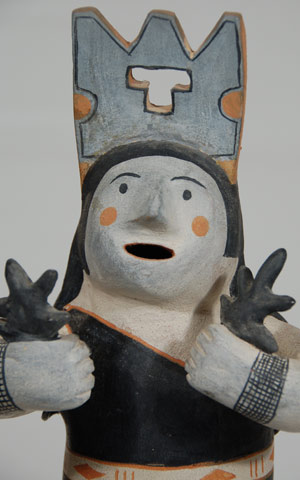Cochiti Pueblo Female Dancer Figurine [SOLD]
+ Add to my watchlist Forward to Friend
- Category: Figurines
- Origin: Cochiti Pueblo, KO-TYIT
- Medium: clay, pigment
- Size: 15-1/2” tall + 1” pedestal
- Item # 25601 SOLD

Females of the pueblo participate with the male dancers during the fall and winter animal dances which are a plea for rain and for bountiful crops as well as an abundance of animals for food. Generally, buffalo, deer, antelope, and ram are portrayed together at a dance in the plaza. The female participants dance along with the males, whereas the males impersonate animals, the females impersonate themselves.
The female dancers wear the traditional pueblo dress that rises above one shoulder and below the other shoulder. It is cinched at the waist with a woven belt. They wear a wooden tablet on their head which is called a tableta, the Spanish word for tablet. It is interesting that the male dancers wear moccasins and the female dance bare footed. In their hands, they carry evergreen boughs during these fall dances.
Naranjo has presented this female figure in the traditional manner of dress and action. Her long black hair flows down her back, she wears a tableta on her head and in her hands are representations of evergreen boughs. She is barefooted. The figurine is signed in pencil Louis Naranjo Cochiti. Although the figurine will stand unassisted, it has been provided with a Plexiglas pedestal and wire support that provides more security. The stand adds another inch to the overall height of the figure.
Condition: original condition.
Provenance: from the collection of Chuck and Jan Rosenak, renowned collectors and authors of Navajo Folk Art.
Recommended Reading: There is an excellent article on Louis and Virginia Naranjo in Indians of New Mexico, edited by Richard C. Sandoval and Ree Sheck. Published by New Mexico Magazine, Santa Fe, 1990. ISBN 0-937206-16-4. It may be available from the publisher.
- Category: Figurines
- Origin: Cochiti Pueblo, KO-TYIT
- Medium: clay, pigment
- Size: 15-1/2” tall + 1” pedestal
- Item # 25601 SOLD



